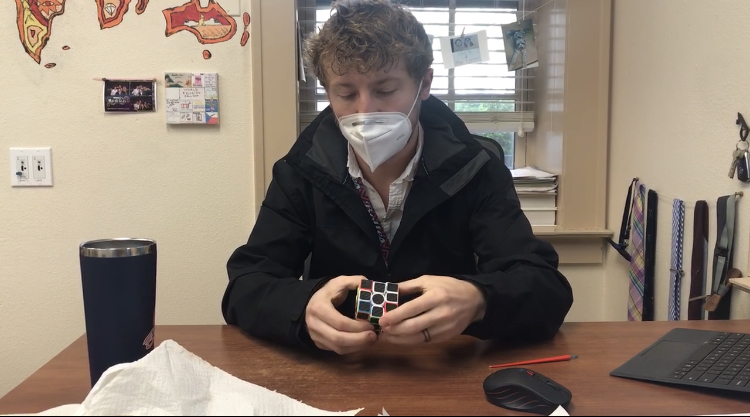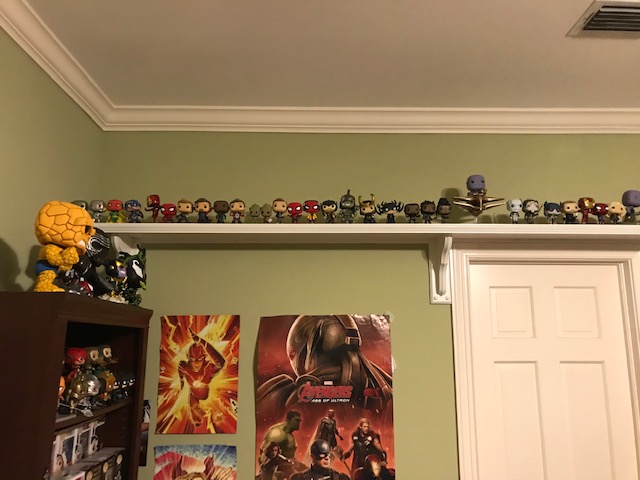Puzzles and Pops: Bolles Collectors
December 13, 2020
Collections: common trope in popular media like video games and fantasy books and movies. From literary hordes, like that of Beowulf’s dragon and the assemblage of the Collector in Guardians of the Galaxy. With all of this, real-life collections often get overlooked. Like the 170 strong Funko Pop collection of Nittin Davuluri (‘24), or the Rubik’s Cube collection of history teacher Mr. Gebauer.
“One day I was just trading in my games at GameStop and I saw these cool collectibles.” Said Davuluri. Since that day, his collection has grown immensely. He has traveled to Conventions across the country, from San Diego to New York to collect different Pops.
If you can go to a GameStop five minutes away and buy a Funko Pop, then why travel 2,339 miles to do the same thing? He traveled for these (a reference to where the image is in the layout): Con stickers. All Pops have stickers, but different stickers denote the value of the Pop.
For example, your average retail Funko Pop likely has a sticker on the box denoting that it is from Target. But a Pop that a collector buys at a Convention will have a sticker indicating which Con it is from, denoting higher value than a retail Pop. The average retail pop goes for around ten to fifteen dollars, while Con Pops can sometimes cost over forty.
The history of Funko Pop and its popularity begins in 1760 when Chinese nodding head figures were first imported to London. Fast forward to 1997, when Mike Becker founded a nostalgic bobblehead company called Wacky Wobblers. However, the Funko Pop we know today debuted in 2010, originally under the name Funko Force 2.0.
Since then, they have skyrocketed in popularity, landing themselves in every Con and major retail chain in the United States, and many more internationally.
Our other resident collector, Mr. Gebauer has a collection more by chance than intention. “Last year [2019] I saw a student solving one and it seemed pretty interesting, so when I saw one at Walmart, I bought it.”
At the beginning of his journey, Gebauer thought he would never be able to solve a Rubik’s Cube. Now he has a personal record time of a minute and a half. “It’s one of those things that’s like it’s kind of cool to overcome a challenge you didn’t think you’d be able to do.”
Since the beginning of his cubing career, Gebauer has obtained a collection of eight cubes, four three by threes, two two by twos, a three-sided pyramid, and a miniature three by three.
Much like Funko Pops, the Rubik’s cube started small. Its story begins in 1974, when Hungarian architect, Ernő Rubik, was trying to make a way to physically illustrate three-dimensional movement to his students. The original prototype of the world-famous toy was fashioned from cubes of wood and paper, held together by glue and rubber bands.
To anyone wondering if Mr. Gebauer is going to quit his job to become a professional Cuber, he assured The Bugle he will not. “The extent of my Rubik’s Cube career is in this classroom.”
—————————————————————-
How to Solve a Rubik’s Cube
After interviewing Mr. Gebauer, the Bugle thought it would be interesting to try to solve a Rubik’s cube ourselves, so we bought a few. We now have the pleasure of presenting you with a tutorial on the solution of a two by two Rubik’s Cube.
R= Right L= Left T= Top B= Bottom Ba= Back F= Front
Step one: your first goal is to solve the white face. Start by getting three white squares on the upper side like this (insert picture) and having the non-white square in the bottom right corner. Then use this algorithm (R down, B left, R up, B right) until it is solved.
Step two: the next goal is to make a row of two cubes of the same color on the top of all of the sides touching the top side (insert picture) Unless you have already achieved this with the previous algorithm, use this algorithm (R down, B left, R up, L down, B right, L up, R down, B right, R up). You will now have one of the matching sets at the top of the cube. Turn that to face away from you and repeat the algorithm
Step three: the next goal is to solve the yellow side opposite to the white side. Check the side opposite to the white side for any yellow squares, if there is one, position it in the bottom left corner. If there are two adjacent to each other, position them on the right. If you have any in any other configurations, position them however you like. Then use the following algorithm until it is solved (R up, T left, Right down, T left, R up, T left x2, R down).
Step four: solve the rest. Look around the cube and see if there are any sides you could solve just by twisting the top or bottom a few times. If there are, solve them and put one at the back of the cube, and then repeat this algorithm (R down, F clockwise, R down, B counterclockwise x2, R up, F counterclockwise, R up, B counterclockwise x2, R up x2, B counterclockwise x2) with the solved yellow side facing up until it is solved, or can be solved just by twisting the top or bottom.
Happy cubing!


